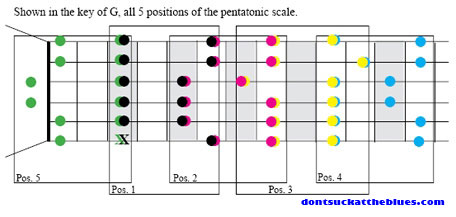| « A Little Monday Morning Blues - with Grigor, Lapple and OBrien | A Little Monday Morning Blues - with TootSweet James and Dan Grigor » |
The Pentatonic Scale – A Pent Up Tonic for your Soul - Part 1
I wanted to explain how the pentatonic scale is an innate aspect of our beings. I wrote and rewrote 500 words. OK, who are we kidding? It was more like 800 words or so about this scale and how it has become a part of us. Then I found this, where, at The World Science Festival in 2009, Bobby McFerrin, using no words at all, performed an amazing display of how ingrained it is in us:
Click through for an amazing video and a little Al Bundy too…
I love the quote at the end, “…anywhere, every audience gets that. It doesn’t matter, you know, it’s the pentatonic scale… for some reason” and he shrugs. Perhaps it is the shrug that says it best. So true this is; we really don’t know why. It is simply a part of us. It needs to be let out, it’s a pent up tonic for your soul.
I had good stuff in those 800 words about history and origins, math and frequencies. It had a fascinating bit about the ancient Greek philosopher Pythagoras, a paragraph about sympathetic harmonic resonance and stuff about right-brain/left-brain interaction, blah, blah, blah, like I was getting paid by the word.
Then I remembered Ed O’Neill as Al Bundy in a classic, hilarious Married with Children episode. Playing the pentatonic scale on a Pastrami Sandwich, “Axle” Bundy jams a 12-bar blues with special guests including Spencer Davis, Richie Havens, Peter Noone (Herman’s Hermits), John B. Sebastian (Lovin’ Spoonful), Mark Lindsay (Paul Revere & the Raiders) and Robby Krieger (The Doors).
I enjoyed the whole episode but the fun begins at around at 4:31.
To me, the history and mathematics are fascinating, but that isn’t what is most important about this scale and it probably isn’t why you are reading this. Let’s lay it out and learn how to use it. We can talk about that other stuff while you practice.
Undoubtedly, the most used and abused scale pattern in history of the world is Position One of the standard pentatonic scale. It is the same pattern as used by McFerrin, Bundy and both Pythagoras the 70’s Symphonic/Prog/Rockers from the Netherlands and (by no small coincidence) Pythagoras the ancient Greek philosopher.
Now it’s your turn.
There are 5 Positions or patterns to learn. Start with Position One, then Two, then Fve then Three then Four. Learning them in that order makes it quicker to start moving around and using more than one position. There is a really easy trick to memorizing them all. They all contain a portion of Position One. After you learn that one, find it in the next one and then learn the other notes.
Picture the pattern in your head as you play it. Use both sides of your brain to learn it. Play it and write it. When you write it, draw the picture of the scale while, in your head, you picture your hand playing it. As you play it, picture your hand writing it.
We want to use all four left-hand fingers, one for each fret. So, for Position One, play fingers 1 and 4 on the sixth string then 1,3/1,3/1,3/1,4/1,4 all the way down. To practice it, start on the 6th, play down to the 1st and play it backwards up to the top again.
Learning scales can be boring; add your own style to make it fun. I usually combine a standard picking technique to make scales practice a finger exercise as well. It is essentially the same trick we use in Don’t Suck at The Blues - Snake Scales Part 2.
Play the 1st note then the 2nd note, then play the 1,2,3, then the 2 then the 3 then 2,3,4 then the 3 then the 4 then the 3,4,5, notes, and so on, all the way down. Then reverse the pattern and go back up. Feel free to add some funk. You can make it a two-handed exercise by alternately picking up, down, up, down, then reverse that too.
Make it interesting. Start on different frets. The X marks the root shown in the key of G, but you can move the whole shebang up to A. Play it up high, play it down low, play it fast, play it slow. Play it over and over and over until it is a bad habit. Get addicted to it. It is going to be with you a long time and if you really learn it, it will never let you down.
Next time we’ll put it to music. Turn on some slow blues and see what you can do til then. Understand that if the song is in the key of “A” and you play the “A” pentatonic scale you cannot hit a wrong note. You can put one in the wrong place, but you can’t play a bad note. Try and match the chord changes with the root notes on down beats. As they play a D chord, you play a D note on the 1 beat; E chord, play an E note. They are in the scale and you should find it easy to pick them out by ear even if you don’t know the names. Go nuts! Stay Tuned! Play lots!



Recent comments